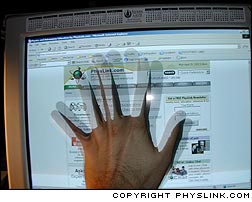Funny Pics of Many Computer Monitors
Why does your hand look funny when you move it fast in front of the tv or computer screen?
Asked by: Ian V.
Answer
The effect is called strobing.
Television refresh rate:
 Television screens and monitors refresh their image at a certain rate, called the refresh rate and which have units of inverse seconds, or Hertz. The refresh is needed in order that the screen can show moving pictures. A good way of think of the refresh is a snapshot of an image that is displayed very quickly. If the number of displays per second are increased, that corresponds to a higher refresh rate. Now, each snapshot is 'flashed' for a short amount of time, sort of like the flash bulb of camera going off. If the number of flashes per second is high enough, your brain will interpret this as a constant light source. For instance, if you look at your monitor you will see a steady light coming from it. In reality the monitor is producing anywhere from 60-100 'flashes' per second.
Television screens and monitors refresh their image at a certain rate, called the refresh rate and which have units of inverse seconds, or Hertz. The refresh is needed in order that the screen can show moving pictures. A good way of think of the refresh is a snapshot of an image that is displayed very quickly. If the number of displays per second are increased, that corresponds to a higher refresh rate. Now, each snapshot is 'flashed' for a short amount of time, sort of like the flash bulb of camera going off. If the number of flashes per second is high enough, your brain will interpret this as a constant light source. For instance, if you look at your monitor you will see a steady light coming from it. In reality the monitor is producing anywhere from 60-100 'flashes' per second.
Visual refresh rate:
The human visual cortex is capable of distinguishing around 25-30 'flashes' per second, or about 25-30 Hertz. Anything that flashes at a faster rate appears as a constant light source. Knowing your visual refresh rate is important if you want to animate a cartoon. You need to display at least 24 cartoons frames, or cells, per second in order to see smooth movement.
Physics of the strobe:
When you wave your hand in front of a strobing light, your hand will block a certain amount of the light and you will see the outline of your hand appearing at certain intervals. These intervals corresponds to the speed of your hand, the refresh rate of your eye, and the refresh rate of the monitor. The difference between the refresh rate of the monitor and the refresh rate of your vision is called the beat frequency. For example, the beat frequency between my eye and my monitor is 80 Hz - 24 Hz = 56 Hz. Note that this beat frequency is still greater than what my eye can see as a refresh.
Now, say you moved your hand at a certain speed across the monitor and very close to (nearly touching) the monitor. The separation distance of images of your hand would be the velocity of your hand divided by the beat frequency, or, as a formula:
Separation distance = (velocity)/(beat frequency)
The number of images you would see is the width of your monitor separation divided by distance you calculated above:
Number of images = (width of monitor) /(separation distance)
So, as an example.
I move my pencil at a speed of 2 meters per second near the surface of the monitor. The beat frequency between my eye and the monitor is 80 Hz - 24 Hz = 56 Hz ~ 60 Hz
Separation distance = (2 meter/second) / (60 Hz) = 3.33 centimeters
Each image would be a centimeter apart. The number of pencils I see are:
Number of pencils = (50 centimeters ) / (3.33 centimeter) = 15
Now for the weird stuff:
You probably notice that as you move your and across the screen, hand is distorted, or bent. To see this effect more clearly, take a pencil or a ruler and wave it across the screen.
The reason for the 'bending' is that in reality the monitor does not 'flash' the entire image all at once, but 'raster scans' the image. This means that the monitor draws the picture one line at a time starting at the top of your screen and ending at the bottom. The monitor does this very fast and can draw the entire screen very quickly. The raster also has a frequency. This frequency is much higher than that of the refresh rate. Using the formulas above, you can determine the image separation distance of this new 'raster' frequency. Since the image is refreshed from top to bottom, you will notice a bending of your finger at the top in the opposite direction of motion. If you were to wave your finger up and down, you would notice that it seems to get thicker.
Uses of the strobe: Other than making your hand look funny, there are many uses for the strobe effect. A car mechanic uses a strobe light to determine how fast your engine is going. By painting a dot on the crank shaft and flashing a light, she can determine how fast the crank is spinning.
The physicist uses the strobe effect to measure the speed or acceleration of objects, or to take pictures of very fast moving objects.
Strobe lights are used in dance halls to entertain the dancers (or make them sick!)
Answered by: Michael Varney, B.S., Physics Graduate Student, University of Colorado, Boulder, Colorado.
maldonadocovid1986.blogspot.com
Source: https://www.physlink.com/education/askexperts/ae473.cfm
0 Response to "Funny Pics of Many Computer Monitors"
Post a Comment